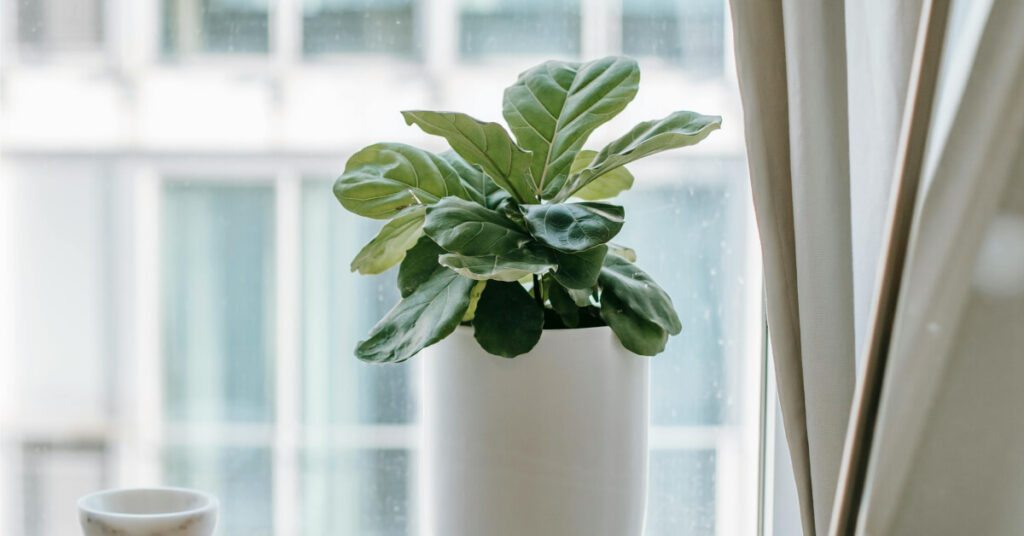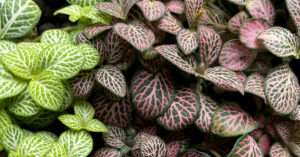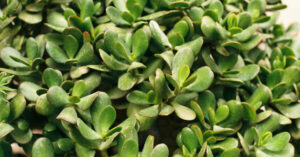Ficus lyrata
Fiddle Leaf Fig stands as the undisputed king of Instagram-worthy houseplants, commanding attention with its enormous, violin-shaped leaves and impressive height. This West African native has become the ultimate statement plant for modern homes, bringing architectural drama and tropical elegance to any space while challenging plant parents to master its specific care requirements.
Why Fiddle Leaf Fig Deserves a Place in Your Home
Native to the rainforests of western Africa, Ficus lyrata has transformed from a towering forest giant into the most coveted indoor plant of the modern era. Its distinctive leaves—broad, glossy, and shaped like a violin or fiddle—can reach up to 18 inches long and 12 inches wide, creating an instant focal point that transforms any room into a sophisticated, magazine-worthy space.
What makes the Fiddle Leaf Fig truly special is its ability to grow as a dramatic floor plant reaching 6-10 feet indoors, yet it can also be maintained as a smaller tabletop specimen through careful pruning. The plant’s upright growth habit and large, architectural leaves make it perfect for filling empty corners, flanking furniture, or creating natural room dividers. Its glossy, deep green foliage reflects light beautifully, brightening spaces while adding that coveted “jungle modern” aesthetic.
Beyond its stunning appearance, the Fiddle Leaf Fig offers the satisfaction of nurturing a plant that truly responds to good care. While it has a reputation for being finicky, understanding its needs leads to vigorous growth and the rewarding experience of watching new leaves unfurl—each one a glossy masterpiece that adds to the plant’s dramatic presence.
Care Requirements
Light Requirements
Bright, indirect light
Fiddle Leaf Fig thrives in bright, indirect light and requires consistent lighting to maintain healthy growth. Place your plant near a large, south or west-facing window where it receives several hours of bright light daily, but protect it from harsh direct sunlight that can scorch the large leaves. The plant can tolerate some morning direct sun but should be shielded from intense afternoon rays.
Consistent lighting is crucial—sudden changes in light conditions can cause leaf drop. If you need to move your plant, do so gradually over several days to prevent shock. During winter months, consider supplementing with grow lights to maintain adequate brightness.
Watering
Moderate – water when top inch of soil dries
Fiddle Leaf Fig prefers consistent moisture but is sensitive to both overwatering and underwatering. Water thoroughly when the top inch of soil feels dry to the touch, typically every 7-10 days during the growing season. Pour water slowly around the base until it drains from the bottom holes, then empty the saucer to prevent standing water.
The key is consistency—erratic watering schedules often lead to leaf drop and stress. During winter, reduce watering frequency as growth slows, but never allow the soil to become completely dry. Always use room temperature water to avoid shocking the roots.
Soil Type
Well-draining potting mix with good organic content
Use a high-quality, well-draining potting mix that retains some moisture while preventing waterlogged conditions. A standard indoor potting soil works well, but consider adding perlite or bark chips to improve drainage. The soil should feel evenly moist after watering but never soggy or waterlogged.
Fiddle Leaf Figs prefer slightly acidic to neutral soil (pH 6.0-7.0). Ensure your pot has adequate drainage holes, as these plants are particularly susceptible to root rot in poorly draining conditions.
Temperature
65-75°F (18-24°C), avoid cold drafts
Fiddle Leaf Fig thrives in warm, stable temperatures typical of most homes but shows extreme sensitivity to temperature fluctuations and cold drafts. Maintain consistent temperatures between 65-75°F for optimal growth. Keep your plant away from air conditioning vents, heating sources, exterior doors, and windows that may cause temperature swings.
Even brief exposure to temperatures below 50°F (10°C) can cause leaf damage and drop. The plant’s large leaves make it particularly sensitive to cold drafts, which can cause rapid leaf loss even in otherwise healthy plants.
Humidity
Medium to high – 40-60% humidity preferred
Higher humidity levels promote healthier growth and help prevent brown leaf edges in Fiddle Leaf Figs. Aim for 40-60% humidity when possible, using humidifiers, pebble trays, or grouping with other plants to create a more humid microenvironment. The plant’s large leaves lose moisture quickly in dry air, making adequate humidity essential for optimal health.
Regular misting is not recommended as it can lead to fungal issues on the large leaves. Instead, focus on increasing ambient humidity around the plant through other methods.
Fertilizing
Monthly during growing season with balanced liquid fertilizer
Fiddle Leaf Fig benefits from regular feeding during its active growing period to support the development of large, healthy leaves. Apply a balanced liquid fertilizer (10-10-10 or similar) monthly from spring through early fall, diluted to half strength to prevent root burn. The plant responds well to consistent nutrition, which promotes vigorous growth and leaf development.
Reduce or eliminate feeding during winter months when growth naturally slows. Over-fertilizing can cause soft, weak growth and increase susceptibility to pests and diseases.
Seasonal Care Adjustments
Spring/Summer (Growing Season):
- Water every 7-10 days when top inch of soil dries
- Monthly fertilizing promotes healthy leaf development
- Ideal time for repotting and pruning
- Monitor for rapid growth and new leaf emergence
- Increase humidity as needed
Fall/Winter (Slower Growth):
- Reduce watering frequency as growth slows
- Stop or significantly reduce fertilizing
- Protect from cold drafts and temperature fluctuations
- Leaf drop may occur naturally—this is normal
- Provide supplemental lighting if needed
Mature Size and Growth Habits
Fiddle Leaf Fig can reach impressive heights of 6-10 feet indoors when grown in optimal conditions, though this typically takes several years. The plant grows from a single trunk or can be encouraged to branch through pruning, creating a fuller, tree-like appearance. Individual leaves can reach 12-18 inches long and 8-12 inches wide, making each leaf a substantial decorative element.
The plant’s growth rate depends heavily on care conditions, particularly light and nutrition. Under ideal conditions, expect 1-2 feet of growth per year, with new leaves emerging from the top of the plant or branch terminals. The newest leaves start small and gradually expand to full size over several weeks.
Difficulty Level
Moderate – requires consistent care and attention to environmental conditions
Fiddle Leaf Fig ranks as moderately challenging, requiring attention to detail and consistent care routines. While not impossible for beginners, it demands understanding of its specific needs and consistent environmental conditions. The plant provides clear feedback about its happiness through leaf condition and growth patterns, making it possible to learn its requirements with careful observation.
Success depends on establishing consistent care routines and maintaining stable environmental conditions rather than advanced plant care knowledge.
Pet and Child Safety
Important: Fiddle Leaf Fig is toxic to pets and children if ingested. The plant contains compounds that can cause mouth irritation, drooling, vomiting, and digestive upset in both animals and humans. The milky sap can also cause skin irritation in sensitive individuals. Place Fiddle Leaf Figs out of reach of curious pets and small children, or consider non-toxic alternatives if ingestion is a concern.
Varieties to Consider
While Ficus lyrata is the most common variety, several cultivars offer different characteristics:
- Ficus lyrata ‘Bambino’: Compact variety with smaller leaves, perfect for tabletops
- Ficus lyrata ‘Compacta’: Slower-growing with denser foliage
- Ficus lyrata ‘Variegata’: Rare variegated form with cream and green markings
- Ficus lyrata ‘Suncoast’: Improved variety with better branching habits
Plants That Pair Well with Fiddle Leaf Fig
Fiddle Leaf Fig’s dramatic presence makes it an excellent anchor plant for tropical and modern plant collections. Its large leaves and upright form provide beautiful contrast when paired with plants of different textures and growth habits.
Perfect Companions:
- Monstera Deliciosa – Complementary large leaves with different shapes
- Snake Plant – Contrasting vertical lines with similar light tolerance
- Rubber Plant – Similar care needs with different leaf characteristics
- Bird of Paradise – Shared tropical origins and comparable size
- Peace Lily – Contrasting flowers with similar humidity preferences
Tropical Collections:
Create lush, jungle-like displays by combining Fiddle Leaf Fig with other large-leafed tropical plants. These combinations thrive in similar conditions and create cohesive tropical environments that transform any space into a green oasis.
Modern Minimalist Pairings:
The architectural form of Fiddle Leaf Fig works beautifully in minimalist settings, either as a single statement piece or paired with simple, clean-lined plants like Snake Plants or ZZ Plants that won’t compete for attention.
Common Problems and Solutions
Leaf Drop
Symptoms: Leaves turning brown and falling off, often starting with lower leaves Solution: Check for overwatering, underwatering, or environmental stress; maintain consistent care routine
Brown Spots on Leaves
Symptoms: Dark brown spots with yellow halos appearing on leaves Solution: Reduce watering frequency, improve air circulation, remove affected leaves
Leaf Edges Turning Brown
Symptoms: Crispy brown edges on leaves, often starting with newer growth Solution: Increase humidity, ensure consistent watering, check for drafts
Pest Issues
Symptoms: Spider mites, scale insects, or mealybugs on leaves and stems Solution: Regular inspection, neem oil treatment, improve air circulation
Leggy Growth
Symptoms: Long stems with sparse leaves, loss of compact form Solution: Increase light exposure, consider pruning to encourage branching
Pruning and Shaping
Fiddle Leaf Fig responds well to pruning, which can encourage branching and maintain desired size and shape:
When to Prune:
- Early spring before active growth begins
- To remove damaged or diseased leaves
- To encourage branching and fuller growth
- To control size and shape
How to Prune:
- Use clean, sharp pruning shears
- Cut just above a leaf node or branch junction
- Remove dead, damaged, or yellowing leaves first
- Make clean cuts to prevent disease entry
- Wear gloves to avoid skin irritation from sap
Repotting
Fiddle Leaf Fig typically needs repotting every 2-3 years or when it becomes root-bound:
- Choose a pot only 1-2 inches larger than the current one
- Ensure adequate drainage holes
- Use fresh, well-draining potting mix
- Be gentle with roots to minimize transplant shock
- Water thoroughly after repotting but avoid fertilizing for 4-6 weeks
Your Statement Plant Success Story
Fiddle Leaf Fig represents the pinnacle of dramatic houseplant beauty, offering the satisfaction of growing a living sculpture that transforms any space into a sophisticated, plant-filled sanctuary. While it requires more attention than some houseplants, the reward of successfully growing this stunning specimen makes every effort worthwhile.
Whether you’re seeking to create an Instagram-worthy plant corner or simply want to add architectural drama to your home, Fiddle Leaf Fig delivers unmatched visual impact. Master its care requirements, and you’ll have a magnificent plant that grows with you for years, becoming more impressive and valuable with each passing season. Few plants offer such dramatic presence and the genuine satisfaction of nurturing a true horticultural masterpiece.




